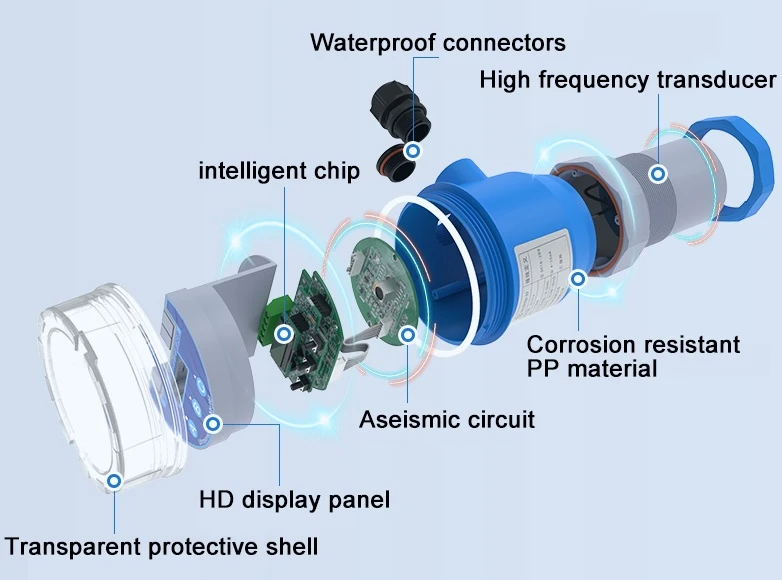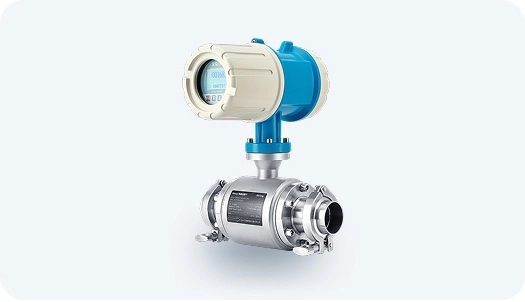-
Date:2025-07-15
-
Page View:253
Ultrasonic level meter, also known as ultrasonic liquid level transmitter, ultrasonic water level meter, ultrasonic material level meter, is an excellent non-contact interface measurement equipment, with high measurement accuracy, easy installation, basic maintenance-free features, commonly used in measuring the level of liquids in a variety of containers, as well as drains, pools, reservoirs, rivers, lakes, and other water level measurements, but also to measure the boundary level, level difference, especially for sewage, corrosive It can also measure the level and level difference, especially suitable for sewage, corrosive occasions, and slot, weir with the nullah flowmeter can also measure the flow, so in the iron and steel, petrochemical, water treatment and water conservancy and many other industries or fields are getting more and more widely used.
Principle of ultrasonic level meter
Ultrasonic level meter is installed in the upper part of the container, under the control of the electronic unit, the probe transmits a beam of ultrasonic pulses to the object to be measured, the sound wave is reflected by the surface of the object, and part of the reflected echo is received by the probe and converted into an electrical signal. The time from the emission of the ultrasonic wave to its re-acceptance is proportional to the distance from the probe to the object under test. The electronic unit detects this time and calculates the measured distance based on the known speed of sound. Using the distance from the probe to the bottom of the tank - the distance from the probe to the liquid level = the actual liquid level or the height of the object, the height of the liquid level is converted into a 4-20 mA current signal, a 1-5 V voltage signal output; or transmitted to the control center via 485 communication, Hart communication, GPRS communication. Since temperature has a large effect on the speed of sound, the instrument should measure the ambient temperature to correct the speed of sound.

Ultrasonic level meter main technical indicators
1. Range and blind zone
Range and blind zone are two important indicators reflecting the ultrasonic level meter.
Range represents the maximum range that the level meter can measure, reflecting the sensitivity of the transducer. In other words, the larger the range, the higher the sensitivity.
The blind zone, also known as the dead zone, is a distance that cannot be measured by the ultrasonic level meter, and it is caused by the aftershock of the ultrasonic transducer. For example, the blind zone is 30 cm, that is to say, when the distance between the liquid surface and the probe is less than 30 cm, there will be a situation that can not be measured. The smaller the blind spot, the better the design of the transducer for the same range.
2. Temperature and Accuracy
Most of the temperature ranges are labeled as -20 to 60 ℃. Because most of the liquid crystal display level meter, the working temperature of the liquid crystal screen can only be in this range, beyond the range, the liquid crystal display will appear abnormal phenomenon. If you do not consider the limitations of the liquid crystal display, generally can be done -40 ~ 80 ℃ range.
In the temperature gradient, the temperature change fast occasions, the measurement error will also increase. In addition to the measurement accuracy of the greatest impact is the gas composition, such as in some volatile liquid occasions, the volatilization of the liquid leads to changes in the air composition, followed by changes in the gas speed of sound, and finally caused by the measurement error.
3. Pressure
In the case of negative pressure, ultrasonic measurement is generally not recommended, because ultrasonic propagation is realized through the gas. Negative pressure means that the air inside the thin air, ultrasound propagation in thin air, one is the speed of sound will change, resulting in measurement errors, and secondly, thin air, acoustic attenuation increases, resulting in a reduction in the measurement range or even can not be measured.
4. Corrosion
ultrasonic level meter corrosion is the main test of the probe material. In the weak acid and alkali environment, ordinary plastic shell can be. Teflon shell, can resist most of the strong acids and alkalis. It is worth noting that if the measured substance has a strong corrosive and volatile, with a one-piece level meter, it is best to glue the circuit board peak. Because most of the shells that can be waterproof are not gas-proof; gas will corrode the circuit board as soon as it enters the inside of the device.
5. Orientation and mounting
Mounting is generally done with both flanges and threads. When installing, the effect of blind zone is generally considered, we have to physically ensure that the distance from the highest liquid level to the probe surface is greater than the blind zone.
6. Power supply and signal output methods
Power supply methods are generally AC power 95 to 230 VAC, 24 VDC four-wire system, 24 VDC two-wire system three. Output methods are: display interface, current 4~20 mA, voltage 1~5 V. Communication methods: 485 communication, Hart communication, GPRS communication and so on.










